GeForce 496.98 Hotfix Driver Performance Analysis – 23 games benchmarked using an RTX 3080 and 2080 Ti
This driver performance analysis showcases the performance of a Gigabyte AORUS RTX 3080 MASTER (Ampere architecture) and an EVGA RTX 2080 Ti BLACK (Turing architecture) with 23 PC games using the latest GeForce 496.98 Game Ready Hotfix driver. We compare this GeForce Hotfix driver versus 496.49 Game Ready drivers with both cards, and we perform all tests on the same game version and the same OS build.
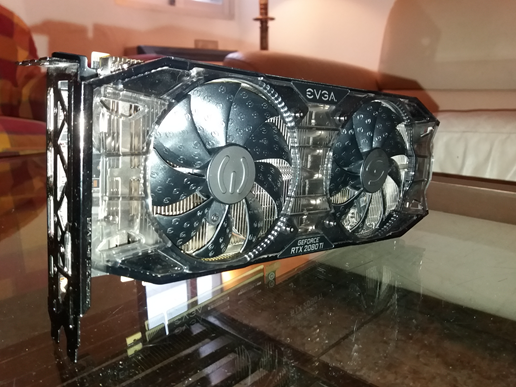
This time our testing platform is a recent install of Windows 11 64-bit Pro Edition, an i9-9900K with stock clocks, a Gigabyte Z390 AORUS PRO motherboard, and 32GB of Kingston DDR4 3333MHz. The games tested, settings and hardware are identical except for the GPUs we use and the drivers we compare.
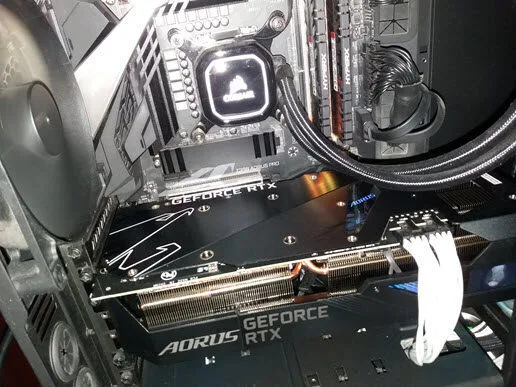
Benching Methodology
Test Configuration – Hardware
- Intel Core i9-9900K (Hyper-Threading/Turbo boost on; stock settings)
- Gigabyte Z390 AORUS PRO motherboard (Intel Z390 chipset, v.F12l BIOS)
- Kingston HyperX Predator 32GB DDR4 (2×16GB, dual-channel at 3333 MHz CL16)
- Gigabyte AORUS GeForce RTX 3080 MASTER 10GB (rev. 1.0); v.F4 VBIOS, stock clocks
- EVGA GeForce RTX 2080 Ti BLACK EDITION GAMING 11GB, stock clocks
- Samsung 500GB SSD 960 EVO NVMe M.2
- WD Blue 1TB SATA SSD
- Corsair RM750x, 750W 80PLUS Gold power supply unit
- ASUS TUF Gaming VG289Q 28? IPS UltraHD (3840×2160) 60Hz 5ms FreeSync Monitor for testing games at 2160p resolution.
- ASUS ROG Swift PG279Q 27? IPS QuadHD (2560 x 1440) 165Hz 4ms G-Sync Monitor for testing games at 1440p resolution.
Test Configuration – Software
- NVIDIA GeForce 496.49 and 496.98 drivers; ‘High Quality’ and ‘prefer maximum performance’ (on a per-game profile-basis); Shader Cache Size ‘Unlimited’ (globally); fixed refresh rate (globally).
- Resizable BAR off
- V-Sync application controlled in the control panel, V-Sync off in-game.
- AA and AF as noted in games; all in-game settings are specified.
- Windows 11 64-bit Pro edition, latest updates v21H2, High-performance power plan, HAGS off, Game Mode, Game DVR & Game Bar features off, Control Flow Guard (CFG) off on a per-game basis.
- GIGABYTE and ASUS tools are not installed.
- Latest DirectX
- All 23 games are patched to their latest versions at the time of publication.
- 3DMark’s suite and UNIGINE Superposition benchmark, the latest version
- Basemark GPU benchmark, v.1.1
- UNIGINE Superposition, v.1.1
- CapFrameX (CX), the latest version
- RivaTuner Statistics Server (RTSS), the latest version
- Display Driver Uninstaller (DDU), the latest version; always uninstall old driver using DDU in safe mode, clean, and restart.
-
ISLC (Purge Standby List) before each benchmark.
GeForce Driver Suite-related
- We use DCH Game Ready drivers.
- The display driver is installed.
- We install the latest version of PhysX.
Hybrid & Non-Synthetic Tests-related
- Single run per test.
Game Benchmarks-related
- The corresponding built-in or custom benchmark sequence is used.
Frametimes Capture & Analysis tool-related
- CapFrameX is used for capturing and analyzing the relevant performance numbers obtained from each recorded built-in or custom benchmark sequence.
- Consecutive runs until detecting 3 valid runs (no outliers) that can be aggregated by CapFrameX using the following method:
- ‘Aggregate excluding outliers’:
- Outlier metric: Third, P0.2 (0.2% FPS percentile).
- Outlier percentage: 3% (the % the FPS of an entry can differ from the median of all entries before counting as an outlier).
- ‘Aggregate excluding outliers’:
- We compare and value the results and aggregated records in terms of percentages of gain/loss, by setting the following thresholds to consider a certain % value as significant (not within the margin of error) for our benchmarking purposes:
- Score/FPS Avg > 3% when valuing hybrid and non-synthetic benchmarks;
- FPS Avg > 3% when evaluating raw performance;
- P1/P0.2 > 3% when evaluating frame time consistency; after applying our custom formula
{[(LowPercentileFPS_2 / AvgFPS_2) / (LowPercentileFPS_1 / AvgFPS_1)] – 1} x 100
Benchmark Suite: 23 PC Games, 4 Hybrid & 4 Non-Synthetic Tests
Hybrid Tests (3DMark)
- DirectX Raytracing feature test
- Fire Strike Ultra
- Port Royal
- Time Spy Extreme
Non-Synthetic Tests
- Basemark GPU
- Boundary: Raytracing Benchmark
- Neon Noir (Benchmark)
- UNIGINE Superposition
DX11 Games
- Borderlands 3 (DX11)
- Chernobylite (DX11)
- Days Gone (DX11)
- Deus Ex: Mankind Divided (DX11)
- Far Cry New Dawn (DX11)
- Neon Noir (DX11; Loop Mode)
- Tom Clancy’s Ghost Ghost Recon Breakpoint (DX11)
DX12 Games
- Borderlands 3 (DX12)
- Cyberpunk 2077 (DX12)
- DIRT 5 (DX12)
- F1 2021 (DX12)
- Far Cry 6 (DX12
- Horizon Zero Dawn (DX12)
- LEGO® Builder’s Journey (DX12)
- Metro Exodus (DX12)
- Metro Exodus PC Enhanced Edition (DX12)
- Myst (2021, DX12)
- Shadow of the Tomb Raider (DX12)
- Tom Clancy’s The Division 2 (DX12)
- Watch Dogs: Legion (DX12)
Vulkan Games
- DOOM Eternal (VK)
- Quake 2 RTX (VK; v.1.5.0)
- Strange Brigade (VK)
- Tom Clancy’s Ghost Recon Breakpoint (VK)
- Wolfenstein Youngblood (VK)
NVIDIA Control Panel settings
Here are the global NVIDIA Control Panel settings:

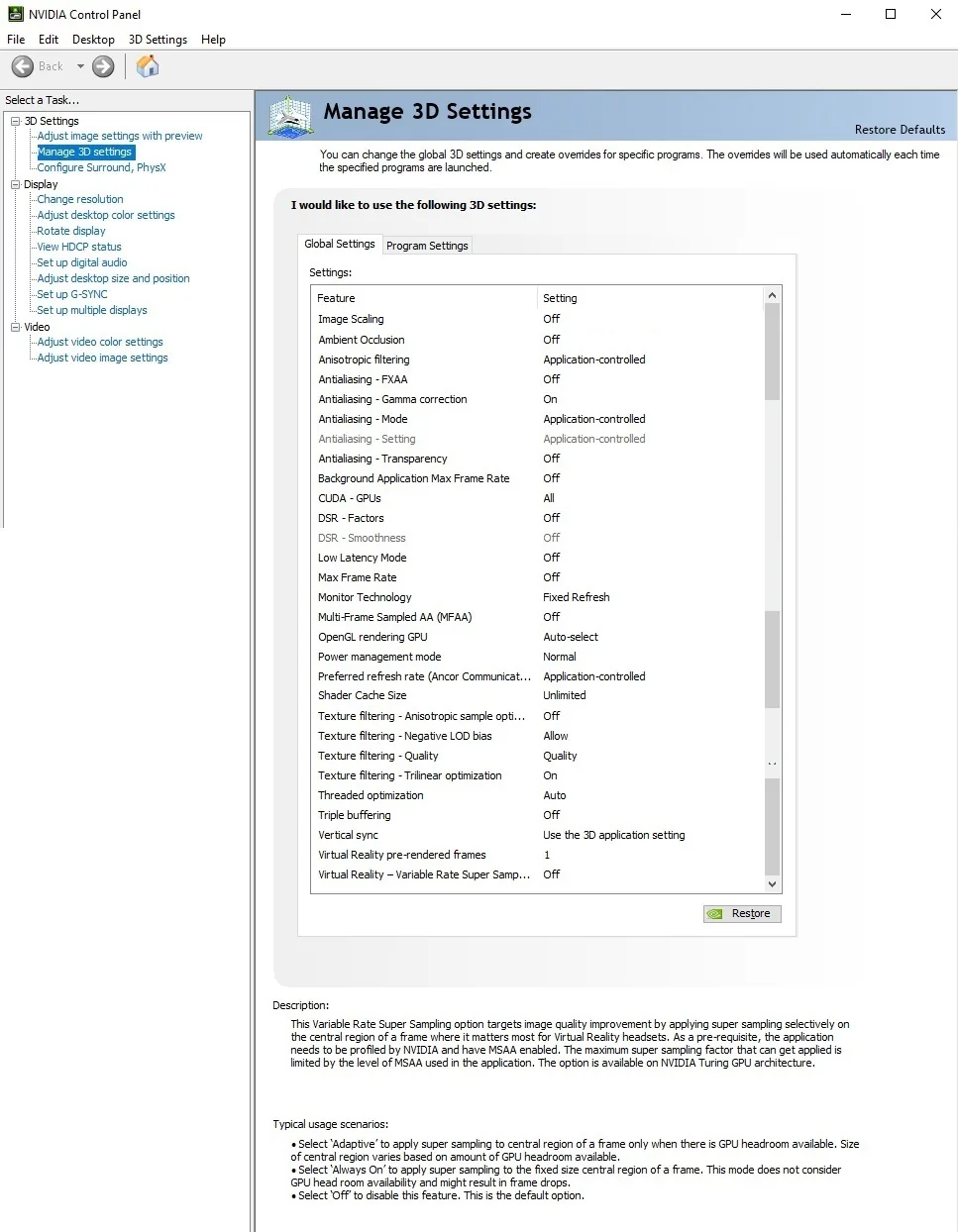
Both ‘High-Quality’ values for texture filtering-quality setting and ‘Prefer maximum performance’ for power management mode are set on a per-game or program profile basis via Manage 3D Settings > Program settings tab.
GeForce 496.98 Hotfix Driver
The GeForce Hotfix display driver version 496.98, based on the latest Game Ready 496.76 drivers, was released on Wednesday (11/24/21) to address the following driver issues:
-
- [YouTube]: The YouTube website randomly displays extreme contrast/gamma while idle or during video playback. [3420164]
- [Notebook]: Black screen may be observed on some Optimus notebooks with 1440p/165hz panels when in discrete GPU mode [3426730]
- Games do not launch correctly on GeForce GTX 750 Ti when NVIDIA Image Scaling is enabled [3442778]
- Using Adaptive Vertical Sync while G-SYNC is enabled may result in a random black screen [3437003]
- [Red Dead Redemption 2/Doom Eternal]: The game crashes with TDR or the system crashes while running the game. [200766423]
It also features the following driver bug fix for NVIDIA Image Scaling pushed through the previously released 496.84 Hotfix driver:
-
- [NVIDIA Image Scaling]: After performing a clean install or over-install over version 496.49, NVIDIA Image Scaling resolutions do not appear in the game. [3434708]
Being based on the GeForce 496.76 Game Ready driver, it also brings support for Battlefield 2042 and Ruined King: A League of Legends Story, and the latest games to leverage DLSS technology, including Assetto Corsa Competizione, Bright Memory: Infinite, Farming Simulator 22, Hot Wheels Unleashed, and Myth of Empires.
GeForce 496.98 Hotfix Driver Performance – Summary Charts with 23 Games
Below you can find the summary charts of our representative selection of 23 games plus 4 hybrid and 4 non-synthetic benchmarks. We chart our games’ driver performance progression from version 496.49 to 496.98 using both the AORUS RTX 3080 MASTER and the EVGA RTX 2080 Ti BLACK.
You can see the list of graphics settings on the charts, and we run each built-in or custom game benchmark’s sequence at 2560×1440, except for Borderlands 3, Days Gone, Far Cry New Dawn, and Far Cry 6 tested at 3840×2160 resolution. You may click on each chart to open a pop-up for the best viewing.
Results give average framerates and higher is better. We display the low FPS percentiles (P1 and P0.2) below the corresponding averages. We use CapFrameX to record frametimes over time and to visualize and convert them into their corresponding average FPS and P1 and P0.2 FPS percentiles values.
There are also columns showing percentages of gain/loss in both raw performance (average FPS) and, when applicable, in frametimes consistency or stability between the different driver versions. We applied the following custom formula to calculate the stability gains or losses:
{[(LowPercentileFPS_2 / AvgFPS_2) / (LowPercentileFPS_1 / AvgFPS_1)] – 1} x 100
We mark significant performance changes (higher than 3%) in bold and use purple for the significant improvements or orange font for regressions.
GeForce 496.98 Hotfix Driver Performance Charts



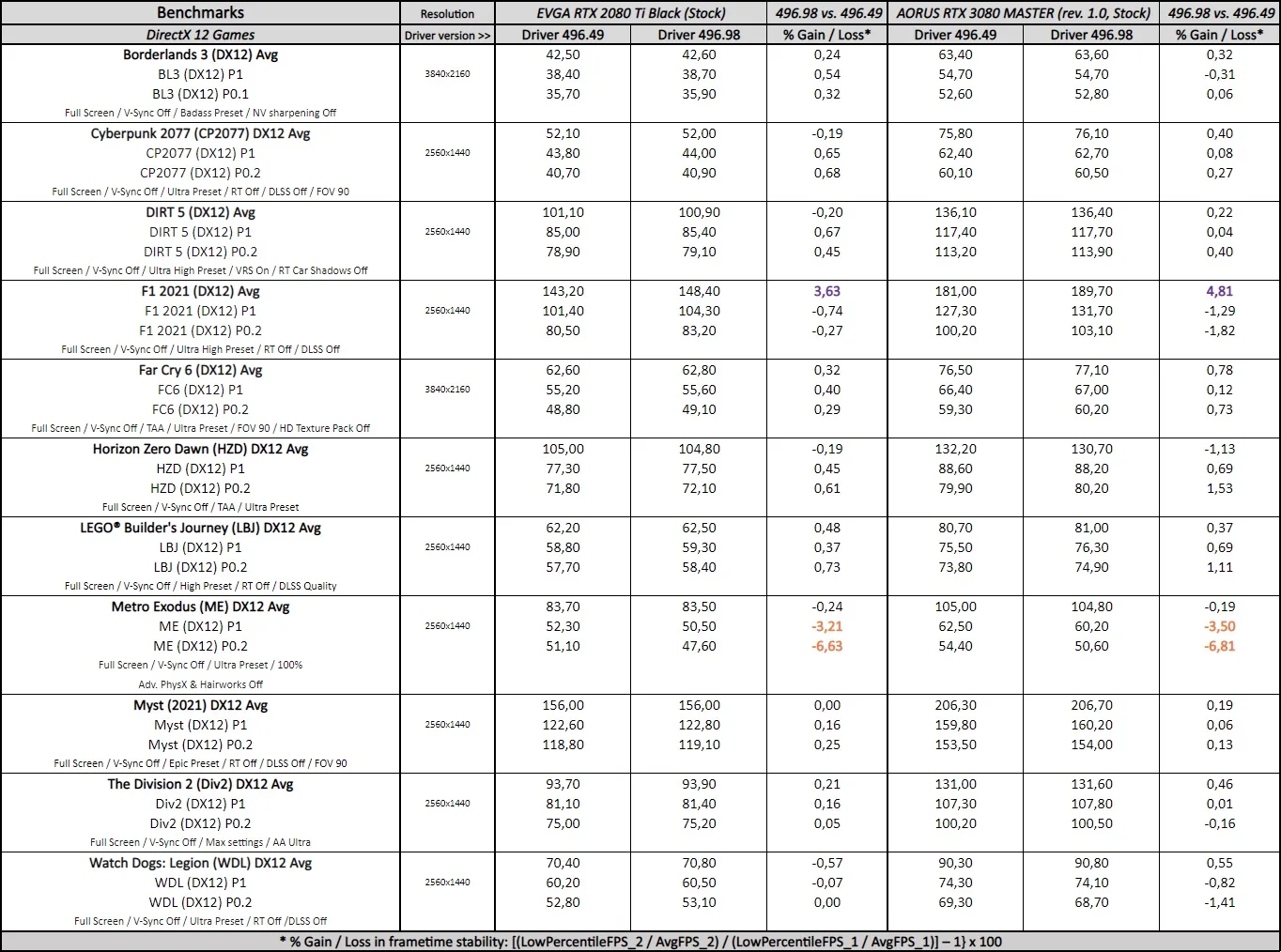

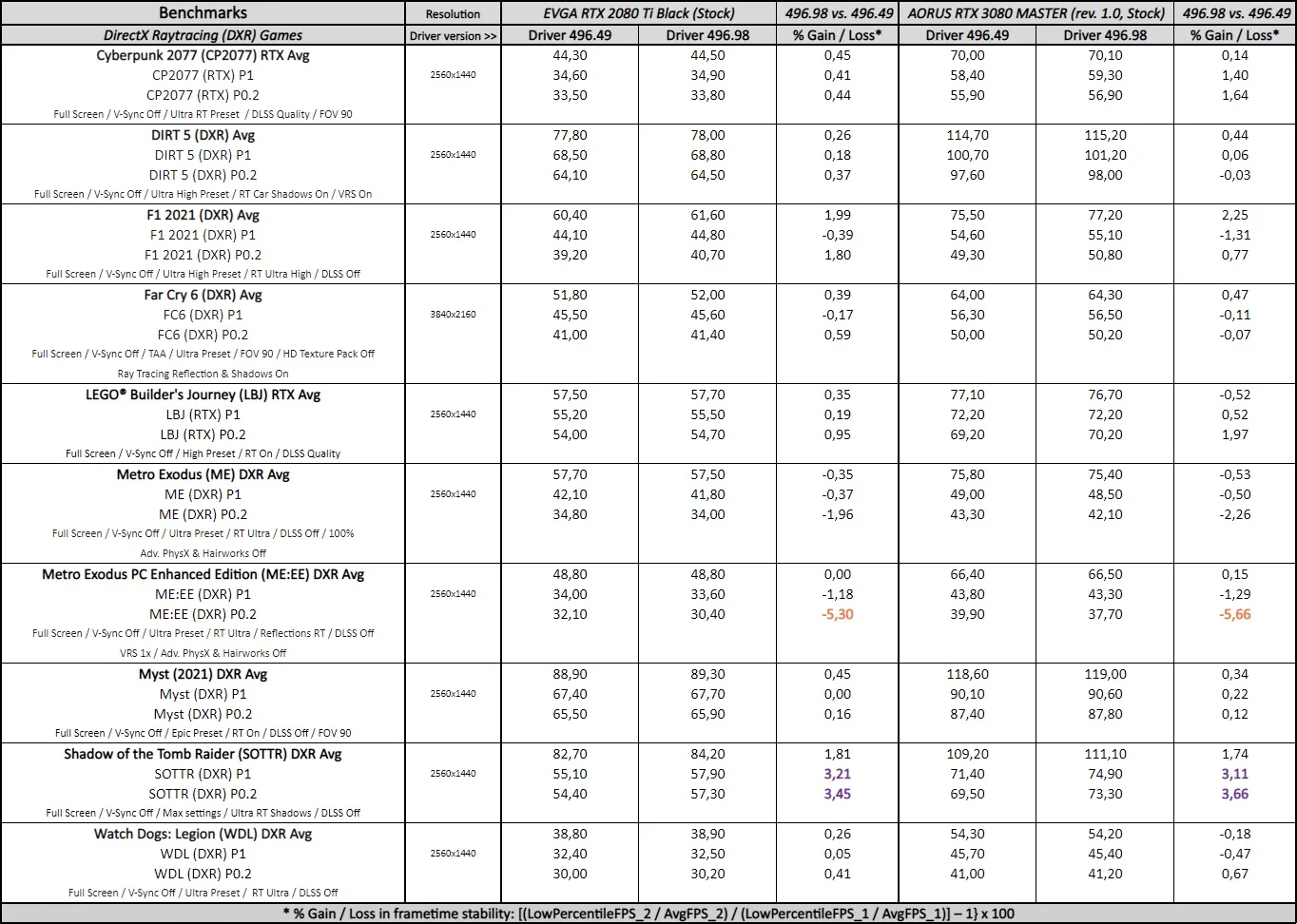

Notes on GeForce 496.98 Hotfix Driver Performance
From the charts, we see no significant differences in graphics performance between drivers for both the hybrid and non-synthetic tests using both our RTX 3080 and RTX 2080 Ti.
For the game benchmarks, although most games show no significant differences when we move to 496.98 drivers from the 496.49 driver version using both GPUs, we see significant performance regressions in Metro: Exodus (vanilla DX12 and Enhanced edition) in terms of frametime consistency, and some noteworthy performance improvements in F1 2021 (DX12) in terms of raw performance, and in Shadow of the Tomb Raider (DXR API mode) in terms of frametime stability.
Disclaimer
Please be aware that the following results, notes, and the corresponding driver recommendation are valid for similar Ampere and Turing gaming rigs on Windows 11 v21H2. Its representativeness, applicability, and usefulness on different NVIDIA GPU architectures, testing benches, and MS Windows versions may vary.
Conclusion
Based on our previous results and findings, we recommend Ampere and Turing users update to the latest GeForce 496.98 Hotfix driver. Its raw performance and smoothness or frametimes consistency level are overall on par with 496.49 Game Ready drivers using both NVIDIA GPU architectures.
From a qualitative point of view, there are important reasons that also make it advisable to upgrade to version 496.98. These reasons include its higher level of driver bug fixes, the optimizations for the latest games, and support for NVIDIA Image Scaling (NIS) and the latest NVIDIA technologies.
We are also pleased to announce that BTR is finally ready to upgrade our current testing platform to Intel’s new flagship i9-12900K/Z690 CPU platform, so this will be our last driver performance analysis using an i9-9900K/Z390 gaming setup.
Stay tuned, and let’s play!
***
Rodrigo González (aka ‘RodroG’) is an enthusiast gamer and tech reviewer especially interested in shooter games, open-world role-playing games, and software and hardware benchmarking. He is the author of the NVIDIA WHQL Driver Performance Benchmarks Series and founder and moderator of the r/allbenchmarks community on Reddit.